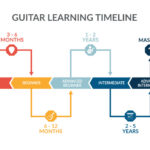The key of D major is a bright and uplifting key, frequently used in popular music across genres like pop, rock, country, and folk. Understanding the Guitar Chords In D Major is fundamental for any guitarist looking to expand their musical vocabulary and play a vast range of songs. Like all major keys, D major has a distinct set of seven chords that harmonically work together to create its characteristic sound.
This guide will provide you with a comprehensive overview of the chords in the key of D major. We’ll not only list the chords but also delve into popular chord progressions and the music theory that explains why these specific chords belong to the key of D. Whether you’re a beginner just starting to explore keys or an experienced player seeking a deeper understanding, this article will enhance your knowledge of guitar chords in D major.
The Essential Chords in D Major
There are seven primary chords in the key of D major, each built upon a different degree of the D major scale. Here’s a table summarizing these chords, including their degree, chord type, and a helpful chart for guitar players:
| Degree | I | ii | iii | IV | V | vi | vii° |
|---|---|---|---|---|---|---|---|
| Chord | D major | E minor | F# minor | G major | A major | B minor | C# diminished |
| Chart |
Understanding Chord Qualities: Notice the pattern in chord types: Major, minor, minor, Major, Major, minor, diminished. This major-minor pattern is consistent across all major keys.
- I (D Major), IV (G Major), V (A Major): These are the major chords, providing a sense of stability and resolution.
- ii (E minor), iii (F# minor), vi (B minor): These are the minor chords, adding emotional depth and complexity.
- vii° (C# diminished): This diminished chord creates tension and is often used as a passing chord leading back to the tonic (D major).
Popular Chord Progressions in D Major
Chord progressions are the backbone of songs, creating musical phrases and sections. Here are some common and effective chord progressions using guitar chords in D major:
| Progression | Chords | Description |
|---|---|---|
| I-IV-V | D-G-A | Classic and widely used progression. |
| I-IV-I-V | D-G-D-A | Variation of I-IV-V, emphasizes the tonic chord. |
| I-V-vi-IV | D-A-Bm-G | Popular in pop and rock, creates a pleasing loop. |
| I-ii-IV-V | D-Em-G-A | Adds a minor chord (ii) for harmonic interest. |
| I-vi-ii-V | D-Bm-Em-A | Another common variation with minor chords. |
| I-vi-IV-V | D-Bm-G-A | Similar to I-V-vi-IV but with a different feel. |
These progressions are excellent starting points for songwriting or for learning to play songs in D major. Experiment with strumming patterns and tempos to find your own musical expression within these frameworks.
Music Theory: Why These Chords Work in D Major
To understand why these specific chords are in the key of D major, we need to explore a bit of music theory, specifically how chords are derived from the D major scale.
The D major scale consists of seven notes:
D – E – F# – G – A – B – C# – D
Each of the seven chords in the key of D major is built upon one of these notes as its root. We construct chords using triads, which are three-note chords consisting of the 1st, 3rd, and 5th degrees of a scale.
To determine whether a chord is major, minor, or diminished, we examine the intervals between these notes.
- Major Triad: 1st, Major 3rd, Perfect 5th
- Minor Triad: 1st, Minor 3rd, Perfect 5th
- Diminished Triad: 1st, Minor 3rd, Diminished 5th
Let’s break down how each chord in D major is formed:
-
D Major (I Chord):
- Root: D
- 3rd degree of D major scale: F#
- 5th degree of D major scale: A
- Notes: D, F#, A (Major Triad)
Alt text: D Major guitar chord diagram, showing finger positions on the fretboard.
-
E Minor (ii Chord):
- Root: E
- 3rd degree from E within D major scale context: G (Minor 3rd from E)
- 5th degree from E within D major scale context: B (Perfect 5th from E)
- Notes: E, G, B (Minor Triad)
Alt text: E Minor guitar chord diagram, illustrating finger placement for the Em chord.
-
F# Minor (iii Chord):
- Root: F#
- 3rd degree from F# within D major scale context: A (Minor 3rd from F#)
- 5th degree from F# within D major scale context: C# (Perfect 5th from F#)
- Notes: F#, A, C# (Minor Triad)
Alt text: F Sharp Minor guitar chord diagram, depicting the fingering for F#m.
-
G Major (IV Chord):
- Root: G
- 3rd degree of G major scale (also within D major scale): B
- 5th degree of G major scale (also within D major scale): D
- Notes: G, B, D (Major Triad)
Alt text: G Major guitar chord diagram, showing how to play the G chord on guitar.
-
A Major (V Chord):
- Root: A
- 3rd degree of A major scale (also within D major scale): C#
- 5th degree of A major scale (also within D major scale): E
- Notes: A, C#, E (Major Triad)
Alt text: A Major guitar chord diagram, illustrating the finger positions for the A major chord.
-
B Minor (vi Chord):
- Root: B
- 3rd degree from B within D major scale context: D (Minor 3rd from B)
- 5th degree from B within D major scale context: F# (Perfect 5th from B)
- Notes: B, D, F# (Minor Triad)
Alt text: B Minor guitar chord diagram, a visual guide for playing Bm chord.
-
C# Diminished (vii° Chord):
- Root: C#
- 3rd degree from C# within D major scale context: E (Minor 3rd from C#)
- 5th degree from C# within D major scale context: G (Diminished 5th from C#)
- Notes: C#, E, G (Diminished Triad)
Alt text: C Sharp Diminished guitar chord diagram, demonstrating finger positions for C#dim.
By understanding this process, you can see how the guitar chords in D major are harmonically connected and derived directly from the D major scale. This knowledge not only helps you memorize the chords but also deepens your understanding of music theory, making you a more informed and versatile guitarist. Explore playing songs in D major and experiment with creating your own chord progressions to solidify your grasp of this essential key.


